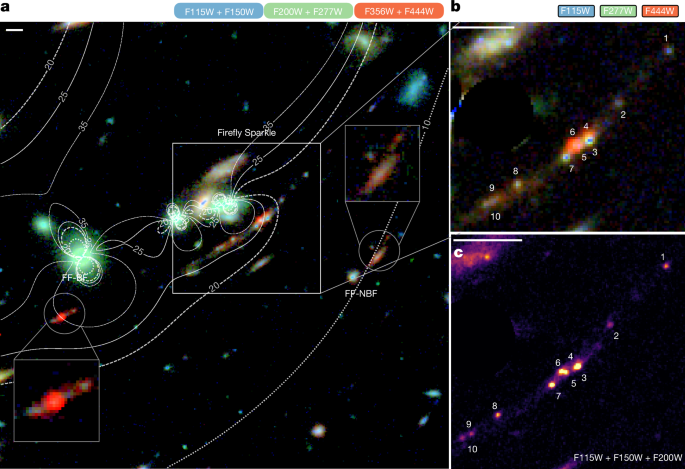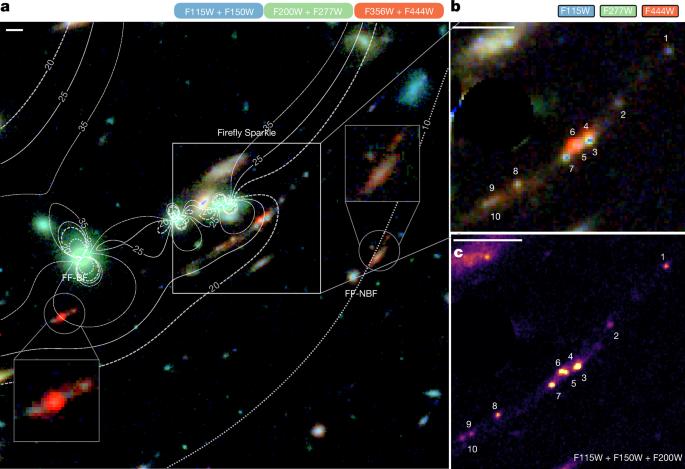在6亿年前的宇宙中,由星团形成的低质量星系
IF 48.5
1区 综合性期刊
Q1 MULTIDISCIPLINARY SCIENCES
引用次数: 0
摘要
探测到的最远星系是在宇宙只有当前年龄5%的时候被观测到的。在这个时期,像银河系这样的星系的前身质量要小1万倍。利用詹姆斯韦伯太空望远镜(JWST)结合引力透镜的放大,这些低质量星系不仅可以被探测到,还可以被详细研究。在这里,我们展示了JWST在zspec = 8.296±0.001处对一个强透镜星系的观测,显示了加拿大无偏星团调查(CANUCS)1中包裹在漫射弧中的大质量星团(Firefly Sparkle)。萤火虫闪耀星系在其早期形成阶段表现出年轻的、富含气体的星系的特征。星系的质量集中在10个星团中(占总质量的49% - 57%),单个质量在105M⊙到106M⊙之间。这些未解析的星团具有很高的表面密度(>103M⊙pc−2),超过了银河系球状星团和邻近星系中的年轻星团。中心星团的光谱以星云为主,金属丰度低,气体密度高,电子温度高,表明其初始质量函数为头重头轻。这些观测为我们提供了第一个典型星系早期阶段的分光光度图,在一个6亿年前的宇宙中。本文章由计算机程序翻译,如有差异,请以英文原文为准。


Formation of a low-mass galaxy from star clusters in a 600-million-year-old Universe
The most distant galaxies detected were seen when the Universe was a scant 5% of its current age. At these times, progenitors of galaxies such as the Milky Way were about 10,000 times less massive. Using the James Webb Space Telescope (JWST) combined with magnification from gravitational lensing, these low-mass galaxies can not only be detected but also be studied in detail. Here we present JWST observations of a strongly lensed galaxy at zspec = 8.296 ± 0.001, showing massive star clusters (the Firefly Sparkle) cocooned in a diffuse arc in the Canadian Unbiased Cluster Survey (CANUCS)1. The Firefly Sparkle exhibits traits of a young, gas-rich galaxy in its early formation stage. The mass of the galaxy is concentrated in 10 star clusters (49–57% of total mass), with individual masses ranging from 105M⊙ to 106M⊙. These unresolved clusters have high surface densities (>103M⊙ pc−2), exceeding those of Milky Way globular clusters and young star clusters in nearby galaxies. The central cluster shows a nebular-dominated spectrum, low metallicity, high gas density and high electron temperature, hinting at a top-heavy initial mass function. These observations provide our first spectrophotometric view of a typical galaxy in its early stages, in a 600-million-year-old Universe. JWST observations of a strongly lensed low-mass galaxy in a 600-million-year-old Universe show massive star clusters (the Firefly Sparkle) cocooned in a diffuse arc in the Canadian Unbiased Cluster Survey.
求助全文
通过发布文献求助,成功后即可免费获取论文全文。
去求助
来源期刊

Nature
综合性期刊-综合性期刊
CiteScore
90.00
自引率
1.20%
发文量
3652
审稿时长
3 months
期刊介绍:
Nature is a prestigious international journal that publishes peer-reviewed research in various scientific and technological fields. The selection of articles is based on criteria such as originality, importance, interdisciplinary relevance, timeliness, accessibility, elegance, and surprising conclusions. In addition to showcasing significant scientific advances, Nature delivers rapid, authoritative, insightful news, and interpretation of current and upcoming trends impacting science, scientists, and the broader public. The journal serves a dual purpose: firstly, to promptly share noteworthy scientific advances and foster discussions among scientists, and secondly, to ensure the swift dissemination of scientific results globally, emphasizing their significance for knowledge, culture, and daily life.
 求助内容:
求助内容: 应助结果提醒方式:
应助结果提醒方式:


